

FET: Fun Endeavors Together
source link: https://hackaday.com/2023/05/02/fet-fun-endeavors-together/
Go to the source link to view the article. You can view the picture content, updated content and better typesetting reading experience. If the link is broken, please click the button below to view the snapshot at that time.
Last time, we’ve looked over FET basics, details, nuances and caveats. Basics aren’t all there is to FETs, however – let’s go through real-world uses, in all their wonderful variety! I want to show you a bunch of cool circuits where a friendly FET, specifically a MOSFET, can help you – and, along the way, I’d also like to introduce you to a few FETs that I feel like you all could have a good long-term friendship with. If you don’t already know them, that is!
Driving Relays
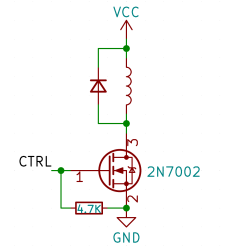
Perhaps, that’s the single most popular use for an NPN transistor – driving coils, like relays or solenoids. We are quite used to driving relays with BJTs, typically an NPN – but it doesn’t have to be a BJT, FETs often will do the job just as fine! Here’s an N-FET, used in the exact same configuration as a typical BJT is, except instead of a base current limiting resistor, we have a gate-source resistor – you can’t quite solder the BJT out and solder the FET in after you have designed the board, but it’s a pretty seamless replacement otherwise. The freewheel (back EMF protection) diode is still needed for when you switch the relay and the coil produces wacky voltages in protest, but hey, can’t have every single aspect be superior.
The reason you can drive it the same way is quite simple: in the usual NPN circuit, the relay is driven by a 3.3 V or a 5 V logic level GPIO, and for small signal FETs, that is well within Vgs. However, if your MCU has 1.8 V GPIOs and your FET’s Vgs doesn’t quite cut it, an NPN transistor is a more advantageous solution, since that one will work as long as you can source the whatever little current and the measly 0.7 V needed.
And here’s our first two friendly transistors, 2N7002 and BSS138 – they’re both small-signal N-FETs, fit for exactly this kind of job. The 2N7002 is a pretty classic part – you will see it a lot in whatever place an N-FET can fit. The BSS138 is very similar, with a tad higher Rds range, but a tad lower Vgs range – you’ll see it in some Sparkfun or Adafruit schematics. You can safely buy a bunch of either of these, and use them in your circuits whenever you need a small N-FET you can drive with a GPIO.
Level Shifting
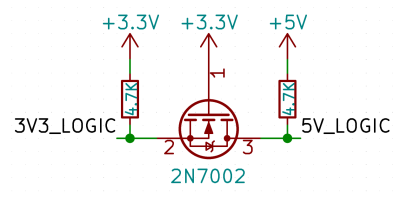
There’s more to small logic-level FETs, of course – for instance, if you ever needed to level-shift a few signals back and forth, you might’ve used those small ‘level shifter’ boards with four SOT23 parts on them. Those SOT23 parts are actually FETs, and our [Jenny List] has covered this kind of shifter in her extensive article about level shifting. This method is also cheap, simple, and will work with the overwhelming majority of the signals you’ll ever want to level-shift – all the more reasons to stock up on small signal N-FETs!
Reverse Polarity Protection
Here’s the ever-so-wonderful circuit that lets you do lossless reverse polarity protection with a FET! You can use either kind of FET – often, a P-FET is used for this, since having uninterrupted common ground has its benefits, but an N-FET will work too. This way of reverse polarity protection is way, way better than using a series diode, because you don’t waste anywhere near as much power – at 1-2A of power consumption, a diode can have you waste over 1W of power into heat.
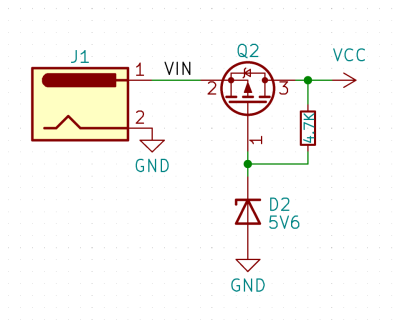
If Vgs isn’t higher than your expected power input, all you need to do is tie a P-FET’s gate to the negative pin, connect the power input to the positive pin, and have the drain pin be the output. Otherwise, if your input voltage might exceed Vgs or reverse Vgs thresholds, you’ll want to add a zener diode and a resistor to clamp the voltage. This kind of reverse polarity protection is cheap, lossless, and can absolutely save your components from a fiery death.
Of course, unless your circuit is quite low-power, you’ll want to move beyond small-signal FETs – what about the power input for a development board you’re working on? Perhaps, you could even use the same kind of FET you’d use for high-side switching peripherals? Let’s look into more powerful FETs – specifically, a few small yet good P-FETs that can handle higher currents without breaking a sweat.
There are quite a few small but powerful FETs with maximum Vgs range from 12V to 24V and maximum Ids around 2A-4A, that fit a large amount of occasions. Some of them have boast logic-level input, which usually means reasonable Rds at Vgs considerably lower than 3.3V logic high level, i.e. 1.8V – if you ever need to switch power to a 3.3V WiFi module and you want to do it with a GPIO, such a FET will fit the bill. Others don’t mark themselves as logic-level, but have reasonable Rds at low Vgs.
Out of my favourite all-purpose higher-current P-FETs, I’ve started out with IRLML6401 and IRLML6402, and now I use their Eastern counterparts, CJ2305 and HX2301A, purely because these are cheaper on LCSC. When it comes to N-FETs of similar caliber, IRLML2502 is great, and AO3400A has been an Eastern-made gadget classic for years. Looking for more? Check out this Ask Hackaday installment, where hackers gave us suggestions on exactly this kind of FETs.
Power Path
We’ve all seen a two-diode circuit, letting you power a circuit from either a DC power input or a battery with seamless switching. However, there’s a problem – while on battery power, having a series diode will have you lose out on a decent chunk of output voltage, and that is especially noticeable when powering a 3.3V circuit from a LiIon battery with its 4.2V-3V voltage range. This circuit takes the load off the battery while it’s charging, powering the load from 5V instead. While having the load perma-connected to the battery in parallel sounds like it could work, you don’t want to interfere with the charger’s CC/CV cycle.
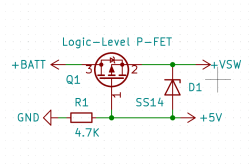 I’ve mentioned this one in the LiIon circuitry article, but it bears a highlight once again – it’s just that great of a circuit to have. Of course, you’ll want a FET that fits the bill, and logic-level P-FETs fit this circuit wonderfully. Oh, and sizing the resistor correctly can help with issues – you can safely go for something like 10 kΩ or even 47 kΩ, but if your circuit brownouts when disconnecting the charger, you can lower it down to as low as 1 kΩ; a FET gate doesn’t need all that much current to stay charged, after all.
I’ve mentioned this one in the LiIon circuitry article, but it bears a highlight once again – it’s just that great of a circuit to have. Of course, you’ll want a FET that fits the bill, and logic-level P-FETs fit this circuit wonderfully. Oh, and sizing the resistor correctly can help with issues – you can safely go for something like 10 kΩ or even 47 kΩ, but if your circuit brownouts when disconnecting the charger, you can lower it down to as low as 1 kΩ; a FET gate doesn’t need all that much current to stay charged, after all.
Keep in mind – compared to the usual high-side switching arrangement, this circuit turns the FET around, swapping drain and source so that 5V doesn’t feed into the battery through the body diode. it will work nevertheless, specifically because the body diode results in voltage on the source pin, but keep in mind that the Vgs threshold has to be calculated by subtracting the body diode drop from the lowest possible battery voltage – the FET might not open otherwise.
Soft Start
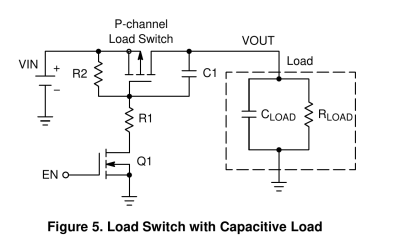
Sometimes, when you switch power to a peripheral like a GSM modem on its own breakout board, with some hefty capacitors on its power rail, it’s going to consume a whole lot of current and dip the voltage – likely, having your microcontroller brownout and reboot. With a single capacitor between gate and drain, you can add primitive soft-start to your high-side-switching P-FET-based circuit – having the FET spend longer time in its linear region as it is being switched on, pre-charging the capacitors before it fully opens, and smoothing out the power draw peak. This is a hack, but it solves the issue, and it’s something you can even bodge in post-production.
Would you like to know more? Here’s a wonderful appnote from onsemi, talking about basics of load switching with FETs, going into both practical examples of it and the math behind it, as well as cases where you might want to use a load switch instead. Oh, and what would those be, by the way?
When A Load Switch Fits Better
It’s hard to match just how well-integrated ICs can be – a single chip can solve all of your problems in a way that a discrete-component solution might never be able to. For instance, let’s say you want to switch a 5V/1.5A load, but you’d also quite benefit from overcurrent protection. With a self-built FET-based load switching solution, you will need to add a current-measuring resistor and an opamp or a comparator, at the very least. On the other hand, a load switch like a SY6280 has all of the features that you could have when building your own high-side switch with FETs, a current limit easily configurable with a single resistor, and even an optional output discharge resistor in case your device could benefit from not having residual voltage after you switch it off.
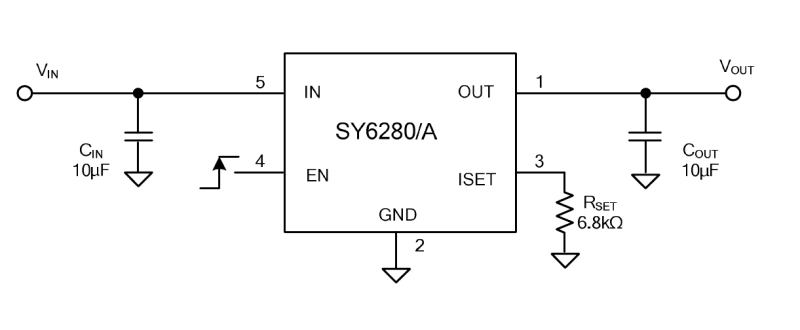
All in all, there’s a large variety of load switches designed to make your circuits less complex and more capable, and they’re not all that much more costly than having an extra FET. They all have FETs inside of them, but they’re GPIO-controllable as a rule – no more need for minding gate capacitance or Vgs. Some of them let you do soft-start, while others might not; some of them have current limiting and other ones don’t, some of them have reverse current flow protection and others don’t, but whatever application you have in mind, you will be able to find a load switch whenever your FET-based circuit starts to get too complex for your needs.
Finding Your Friends
Of course, sometimes you’ll be left needing a very specific FET, some use case that you don’t have a familiar candidate for. At such a point, you’ll have to refer to a part picker – and it might feel a bit intimidating to do so, as there’s quite a few parameters to. For a start, go for SMD FETs for most above-mentioned usecases – through-hole FETs are quite rare for something like “20V Vds max, 3A Ids max”, and SMD FETs in their typical packages are quite solderable. In other words, you don’t need to look into THT parts when you have to go higher-power.
For the same characteristics, N-FETs are going to be slightly cheaper than P-FETs, they will have slightly lower Rds, and they might be more easily available. This is not something you usually have the freedom to pick betweet, but at the point when you do have control over the circuit, perhaps going for an N-FET for your high-power switching tasks is a good idea. Having picked your type of FET, limit by that category, and perhaps limit by the number of channels too – either one or two are a decent choice, but generally it makes sense to have single-channel ones unless you’re using many similar FETs in your circuit.
With main parameters, the most crucial are Vds and Id, so you can start by limiting your choice by these; do a healthy over-spec on your maximum voltage expected, you really don’t want to stay near the expected maximum values during real-world use, so having at least 20% of leeway, or even way more for inductive loads, is a good idea. However, going too far above on either of these parts might get you to parts with unreasonably large Vgs needed, so there’s no need to go too far. In other words, you’ll want at least a 30V/3A FET for switching a 24V/2A LED strip, while a 45V/5A FET will be too high.
After limiting the Vds and Ids range, you can finish by filtering out any kinds of packages you might not want to hand-solder – for SMD specifically, limiting yourself to SOT- and SO- is a good idea if you don’t have a hot air gun. At this point, you should have a decently small number of FETs – this is a moment where you can filter out the few Vgs threshold and Rds outliers left, then sort by price and see what the low-end options available to you are. Find a few where Vgs looks surface-level satisfactory, then go to the datasheet and check through the graphs. At the Vgs you’re able to provide, does Rds look reasonable?
Abundant, Universal, Helpful
There’s way more recipes for FET use in your circuits than these. You will see PWM controllers, motor controllers, electronics loads, protection circuits, – a FET might just have a well-deserved place on your board, and it is wonderful if you’re comfortable using them. Next time you’re looking into handling a bit of power, or a lot of power, a friendly FET might just be the best help you can get.
Recommend
About Joyk
Aggregate valuable and interesting links.
Joyk means Joy of geeK